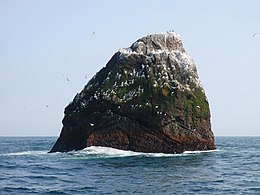 Rockall in 2008 | |
 Topographic map centred on Rockall | |
| Geography | |
|---|---|
| Location | North-east Atlantic |
| Coordinates | 57°35′46.7″N 13°41′14.3″W / 57.596306°N 13.687306°W |
| OS grid reference | MC035165 |
| Area | 784.3 m2 (8,442 sq ft) |
| Highest elevation | 17.15 m (56.27 ft) |
| Administration | |
| Country | Scotland |
| Council area | Comhairle nan Eilean Siar |
| Demographics | |
| Population | 0 |
Rockall (/ˈrɒkɔːl/) is an uninhabitable granite islet in the North Atlantic Ocean. The United Kingdom claims that Rockall lies within its territorial sea[1] and is part of its territory, but this claim is not recognised by Ireland.[2][3] It and the nearby skerries of Hasselwood Rock and Helen's Reef are the only emergent parts of the Rockall Plateau. The rock was formed by magmatism as part of the North Atlantic Igneous Province during the Paleogene.
Rockall's approximate distances from the closest islands in each direction are as follows: It is 301 kilometres (187 statute miles; 163 nautical miles) west of Soay, St Kilda, Scotland;[4] 423 kilometres (263 statute miles; 228 nautical miles) northwest of Tory Island, Ireland;[5] and 700 kilometres (430 statute miles; 380 nautical miles) south of Iceland.[6] The nearest permanently inhabited place is North Uist, an island in the Outer Hebrides of Scotland, 370 kilometres (230 mi; 200 nmi) to the east.[3]
The United Kingdom claimed Rockall in 1955 and incorporated it as a part of Scotland in 1972. The UK does not make a claim to an extended exclusive economic zone (EEZ) based on Rockall, as it has ratified the United Nations Convention on the Law of the Sea (UNCLOS), which says that "rocks which cannot sustain human habitation or economic life of their own shall have no exclusive economic zone or continental shelf".[1] However, such features are entitled to a territorial sea extending 12 nautical miles (22 kilometres). Ireland's position is that Rockall does not even generate a 12-nautical-mile territorial sea for the United Kingdom owing to the UK's uncertain title to Rockall.[7][8] Ireland does not recognise the UK's claim, although it has never sought to claim sovereignty of Rockall for itself.[9][10] The consistent position of successive Irish governments has been that Rockall and similar rocks and skerries have no significance for establishing legal claims to mineral rights in the adjacent seabed or to fishing rights in the surrounding seas.[9]
- ^ a b Cite error: The named reference
whatdotheyknow.comwas invoked but never defined (see the help page). - ^ Cite error: The named reference
EEZwas invoked but never defined (see the help page). - ^ a b "Who owns Rockall? A history of disputes over a tiny Atlantic island". The Irish Times. 8 June 2019. Retrieved 16 December 2020.
- ^ Cite error: The named reference
GoogleEarthStKildawas invoked but never defined (see the help page). - ^ Cite error: The named reference
GoogleEarthTorywas invoked but never defined (see the help page). - ^ Follett, Christopher (28 November 2016). "Watch out for the big rock: Remembering Denmark's greatest maritime disaster". cphpost.dk. Copenhagen Post Online. Retrieved 15 May 2020.
- ^ Clive R. Symmons "Ireland and the Rockall Dispute: An Analysis of Recent Developments" contained in IBRU Boundary and Security Bulletin Spring 1998 at page 81 "Ireland has... even rejected imposition of a 12-mile fishery zone (or territorial sea) around the rock."
- ^ Spring, Dick (25 September 1996). "Dáil Éireann debate: Written Answers. – UN Convention on the Law of the Sea".
At present the United Kingdom claims a 12-mile territorial sea around Rockall, a claim which — depending as it does on jurisdiction over the rock – Ireland has likewise not accepted.
- ^ a b Cite error: The named reference
oir-2016was invoked but never defined (see the help page). - ^ McClafferty, Enda (13 June 2019). "Fishing row 'political stunt' by SNP". BBC News.